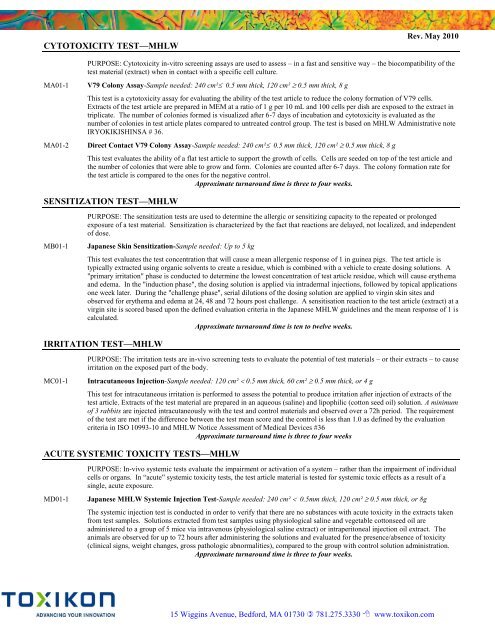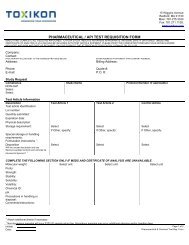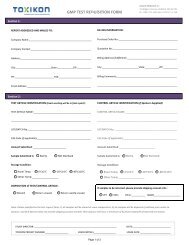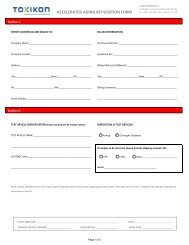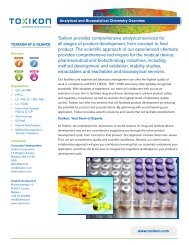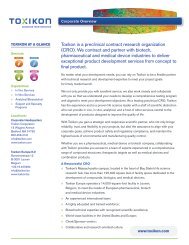Medical Device Testing Guide - Toxikon Corporation
Medical Device Testing Guide - Toxikon Corporation
Medical Device Testing Guide - Toxikon Corporation
You also want an ePaper? Increase the reach of your titles
YUMPU automatically turns print PDFs into web optimized ePapers that Google loves.
CYTOTOXICITY TEST—MHLW<br />
Rev. May 2010<br />
PURPOSE: Cytotoxicity in-vitro screening assays are used to assess – in a fast and sensitive way – the biocompatibility of the<br />
test material (extract) when in contact with a specific cell culture.<br />
MA01-1<br />
MA01-2<br />
V79 Colony Assay-Sample needed: 240 cm² 0.5 mm thick, 120 cm² 0.5 mm thick, 8 g<br />
This test is a cytotoxicity assay for evaluating the ability of the test article to reduce the colony formation of V79 cells.<br />
Extracts of the test article are prepared in MEM at a ratio of 1 g per 10 mL and 100 cells per dish are exposed to the extract in<br />
triplicate. The number of colonies formed is visualized after 6-7 days of incubation and cytotoxicity is evaluated as the<br />
number of colonies in test article plates compared to untreated control group. The test is based on MHLW Administrative note<br />
IRYOKIKISHINSA # 36.<br />
Direct Contact V79 Colony Assay-Sample needed: 240 cm² 0.5 mm thick, 120 cm² 0.5 mm thick, 8 g<br />
This test evaluates the ability of a flat test article to support the growth of cells. Cells are seeded on top of the test article and<br />
the number of colonies that were able to grow and form. Colonies are counted after 6-7 days. The colony formation rate for<br />
the test article is compared to the ones for the negative control.<br />
Approximate turnaround time is three to four weeks.<br />
SENSITIZATION TEST—MHLW<br />
MB01-1<br />
PURPOSE: The sensitization tests are used to determine the allergic or sensitizing capacity to the repeated or prolonged<br />
exposure of a test material. Sensitization is characterized by the fact that reactions are delayed, not localized, and independent<br />
of dose.<br />
Japanese Skin Sensitization-Sample needed: Up to 5 kg<br />
This test evaluates the test concentration that will cause a mean allergenic response of 1 in guinea pigs. The test article is<br />
typically extracted using organic solvents to create a residue, which is combined with a vehicle to create dosing solutions. A<br />
"primary irritation" phase is conducted to determine the lowest concentration of test article residue, which will cause erythema<br />
and edema. In the "induction phase", the dosing solution is applied via intradermal injections, followed by topical applications<br />
one week later. During the "challenge phase", serial dilutions of the dosing solution are applied to virgin skin sites and<br />
observed for erythema and edema at 24, 48 and 72 hours post challenge. A sensitisation reaction to the test article (extract) at a<br />
virgin site is scored based upon the defined evaluation criteria in the Japanese MHLW guidelines and the mean response of 1 is<br />
calculated.<br />
Approximate turnaround time is ten to twelve weeks.<br />
IRRITATION TEST—MHLW<br />
MC01-1<br />
PURPOSE: The irritation tests are in-vivo screening tests to evaluate the potential of test materials – or their extracts – to cause<br />
irritation on the exposed part of the body.<br />
Intracutaneous Injection-Sample needed: 120 cm² 0.5 mm thick, 60 cm² 0.5 mm thick, or 4 g<br />
This test for intracutaneous irritation is performed to assess the potential to produce irritation after injection of extracts of the<br />
test article. Extracts of the test material are prepared in an aqueous (saline) and lipophilic (cotton seed oil) solution. A minimum<br />
of 3 rabbits are injected intracutaneously with the test and control materials and observed over a 72h period. The requirement<br />
of the test are met if the difference between the test mean score and the control is less than 1.0 as defined by the evaluation<br />
criteria in ISO 10993-10 and MHLW Notice Assessment of <strong>Medical</strong> <strong>Device</strong>s #36<br />
Approximate turnaround time is three to four weeks<br />
ACUTE SYSTEMIC TOXICITY TESTS—MHLW<br />
PURPOSE: In-vivo systemic tests evaluate the impairment or activation of a system – rather than the impairment of individual<br />
cells or organs. In ―acute‖ systemic toxicity tests, the test article material is tested for systemic toxic effects as a result of a<br />
single, acute exposure.<br />
MD01-1<br />
Japanese MHLW Systemic Injection Test-Sample needed: 240 cm² 0.5mm thick, 120 cm² 0.5 mm thick, or 8g<br />
The systemic injection test is conducted in order to verify that there are no substances with acute toxicity in the extracts taken<br />
from test samples. Solutions extracted from test samples using physiological saline and vegetable cottonseed oil are<br />
administered to a group of 5 mice via intravenous (physiological saline extract) or intraperitoneal injection oil extract. The<br />
animals are observed for up to 72 hours after administering the solutions and evaluated for the presence/absence of toxicity<br />
(clinical signs, weight changes, gross pathologic abnormalities), compared to the group with control solution administration.<br />
Approximate turnaround time is three to four weeks.<br />
15 Wiggins Avenue, Bedford, MA 01730 781.275.3330 www.toxikon.com


